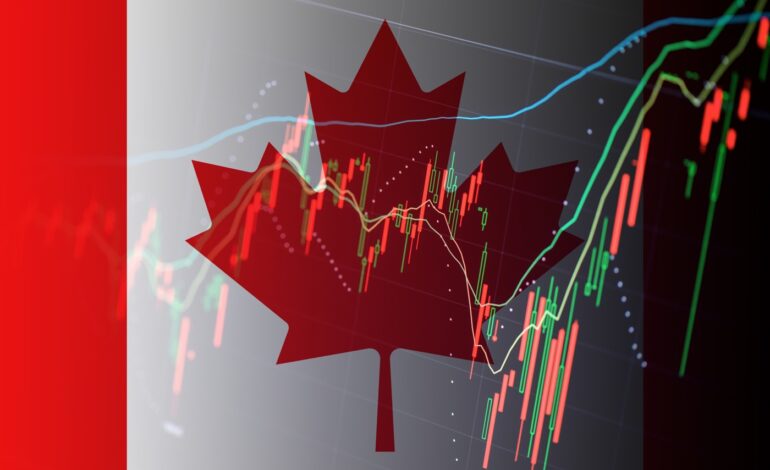
Canada GDP Growth Rate: Economic Trends and Future Outlook
Introduction
Understanding the Canada GDP growth rate is vital to comprehending the health and trajectory of the country’s economy. Gross Domestic Product (GDP) growth reflects the value of all goods and services produced over time and signals whether the economy is expanding or contracting. Canada’s growth rate has seen fluctuations due to factors such as commodity prices, global trade conditions, internal policy shifts, and more recently, post-pandemic recovery patterns. This article provides a comprehensive overview of the historical, current, and future outlook of Canada’s GDP growth rate, supported by analysis of key economic drivers, provincial contributions, sectoral dynamics, and fiscal strategies.
Historical Overview of Canada GDP Growth Rate
Canada’s economy has historically relied heavily on its natural resource base, including oil, gas, and minerals. From the post-World War II boom into the early 1980s, Canada enjoyed strong GDP growth driven by industrialization, immigration, and a stable global trading environment. The 1990s, however, were marked by a slowdown, largely due to fiscal restraint and global financial uncertainty.
The early 2000s brought renewed growth, averaging around 3% annually, with strong support from energy exports and housing market expansion. However, the 2008 global financial crisis delivered a sharp shock, pulling Canada’s GDP growth rate into negative territory for the first time in years.
Despite this setback, the country bounced back relatively quickly compared to other developed economies. The period from 2010 to 2019 saw moderate and steady GDP growth averaging around 1.7% to 2.5% annually. The COVID-19 pandemic in 2020 triggered another major contraction, with GDP shrinking approximately 5.4%—the worst since World War II.
Recent Trends and Recovery Patterns
The year 2021 marked a period of rapid recovery as government stimulus programs, low interest rates, and rebounding global demand fueled a resurgence in economic activity. Canada’s GDP growth rate rebounded sharply, growing by around 4.5% in 2021. However, by mid-2022 and into 2023, economic momentum began to slow, primarily due to inflation, rising interest rates, and global supply chain disruptions.
The Bank of Canada responded with a series of interest rate hikes aimed at taming inflation, which had reached multi-decade highs. While these measures successfully brought inflation down, they also dampened consumer spending and borrowing, causing GDP growth to moderate.
As of the most recent fiscal quarters, the Canada GDP growth rate has been hovering between 0.5% and 1.5% annually, depending on the quarter, reflecting a cooling economy and the risk of entering a technical recession if two consecutive quarters show contraction.
Key Factors Affecting Canada GDP Growth Rate
1. Resource Sector Dependency
Canada’s economic performance is significantly influenced by commodity prices, particularly oil and gas. When global energy prices rise, the country’s GDP often sees an uptick. However, this reliance also makes Canada vulnerable to price shocks and global demand fluctuations.
2. Trade and Exports
Canada is one of the most trade-dependent nations among the G7. Its GDP is tightly tied to the U.S. economy, its largest trading partner. Fluctuations in global demand for Canadian goods such as lumber, metals, and agricultural products can heavily influence GDP performance.
3. Immigration and Labor Force Growth
Canada’s population growth, primarily driven by immigration, contributes positively to GDP expansion. A younger and more diverse labor force supports both productivity and consumption, two critical components of economic growth.
4. Real Estate and Construction
Housing development has been a strong contributor to Canada’s GDP. However, tightening monetary policy and affordability challenges are curbing construction growth. Real estate continues to play a dual role in both stimulating growth and presenting long-term financial stability risks.
5. Technological Advancement
The rise of Canada’s tech sector, particularly in cities like Toronto, Vancouver, and Montreal, has added a new dimension to GDP growth. Tech jobs are generally high-paying and innovation-driven, boosting both productivity and tax revenues.
Sectoral Contributions to Canada GDP Growth
Services Sector
Accounting for nearly 70% of the economy, services are a major growth engine. Banking, insurance, health care, education, and retail trade are among the largest contributors. During the pandemic, many services were hit hard but rebounded quickly with digital adaptation.
Manufacturing
While manufacturing’s share of GDP has declined over the decades, it remains vital, especially in Ontario and Quebec. Key industries include automotive, aerospace, and food processing.
Agriculture and Mining
Although these sectors contribute a smaller portion of total GDP, they are essential for exports. Canada’s wheat, canola, and timber exports are globally competitive, while mining continues to support employment in rural areas.
Regional Contributions and Disparities
Canada’s GDP is not evenly distributed. Provinces like Ontario and Alberta contribute significantly due to their size and resource wealth. British Columbia benefits from trade with Asia, while Quebec’s manufacturing and service sectors are robust.
Conversely, smaller provinces such as Newfoundland and Labrador or Prince Edward Island have less impact on national figures but face unique economic challenges and opportunities.
Fiscal and Monetary Policy Influence
The Bank of Canada and federal fiscal policies are central to GDP management. Monetary tightening in response to inflation typically slows GDP growth in the short term, while government spending can stimulate demand. In recent years, balancing economic stimulation with inflation control has been a major policy focus.
Federal investments in infrastructure, green energy, and housing are intended to support long-term growth, while also addressing affordability and sustainability concerns.
Future Outlook for Canada GDP Growth Rate
Looking ahead, most analysts predict modest GDP growth for Canada over the next three to five years. Forecasts suggest a range of 1.2% to 2.0% annually, depending on global economic conditions, domestic policy responses, and the performance of key sectors like technology, clean energy, and services.
Major risks include:
-
A prolonged slowdown in global trade
-
Higher-than-expected interest rates
-
Climate change and natural disasters impacting agriculture and infrastructure
On the upside, strong immigration, labor force participation, and innovation may drive higher-than-expected growth if effectively harnessed.

Frequently Asked Questions (FAQs)
What is the current Canada GDP growth rate?
As of the latest quarterly data, Canada’s GDP growth rate is approximately 1.1% year-over-year. However, this figure fluctuates quarterly.
What is considered a healthy GDP growth rate for Canada?
Economists generally consider a rate between 2% and 3% to be healthy for a mature economy like Canada, balancing growth with inflation control.
How does inflation affect GDP growth in Canada?
High inflation erodes consumer purchasing power, prompting the Bank of Canada to raise interest rates, which can slow economic growth and reduce the GDP growth rate.
Which sector contributes the most to Canada’s GDP?
The services sector is the largest contributor, followed by manufacturing, real estate, and natural resources.
How do global oil prices impact Canada’s GDP?
Canada is a major oil exporter, so rising oil prices typically boost GDP, while falling prices can reduce national income and investment in energy infrastructure.
Can immigration help increase Canada’s GDP growth rate?
Yes, immigration contributes to labor force expansion and domestic demand, both of which can increase GDP over time.
What is the Bank of Canada’s role in managing GDP growth?
The Bank controls monetary policy, mainly through interest rates. By adjusting rates, it influences borrowing, spending, and investment, thereby impacting GDP growth.
Conclusion
The Canada GDP growth rate is a critical measure of national economic health. It reflects how businesses, consumers, and governments are performing in a rapidly changing global landscape. From resource dependency to technological innovation, from housing booms to policy decisions, many interconnected factors shape Canada’s economic trajectory.
While the coming years present challenges—from inflation to global instability—Canada’s diversified economy, robust immigration strategy, and forward-looking policies offer reasons for cautious optimism. Monitoring the GDP growth rate will remain essential for policymakers, investors, and citizens alike as Canada navigates the next chapter of economic development.






